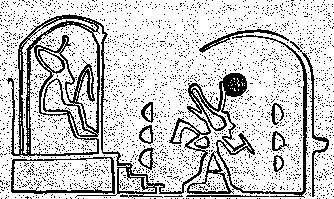|
The parallel text
in H does not have the glyph sequence below, probably because the
beginning of side b must be in order and there was not enough space left on side a to
include this sequence of
glyphs.
To save space I
have not included in the table below the parallel text of Q:
Pb2-16 secures the reading 'winter solstice' for the described events. We have established in the niu chapter how this glyph type (there appearing in Eb6-1, in the 24th and last period of the E calendar) means the gap between the old and new years:
In ancient Egypt Old Pharaoh (Sun) leaves by entering the palace-chapel ('into which the god-king would retire for his changes of costume'. There he spent his time in the 'gap', the time between the full year and the regulated 360 day year. '... Five days of illumination, called the 'Lighting of the Flame' (which in the earlier reading of this miracle play would have followed the quenching of the fires on the dark night of the moon when the king was ritually slain), preceded the five days of the festival itself; and then the solemn occasion (ad majorem dei gloriam) commenced. The opening rites were under the patronage of Hathor. The king, wearing the belt with her four faces and the tail of her mighty bull, moved in numerious processions, preceded by his four standards, from one temple to the next, presenting favors (not offerings) to the gods ...' In Polynesia the natural way of leaving for the old Sun is by canoe, which may explain why vaha mea is followed by canoe:
The last night moon is visible is the 28th, in the 29th night everything is black. Not only in ancient Egypt the fires were quenched in the dark night of the moon. |








